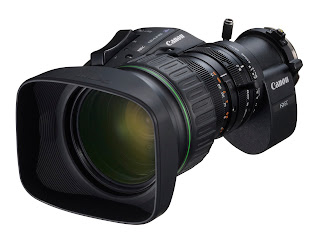The HDC-Z10000 is aimed at bridging the gap between amateur and professional user in both quality and cost.
It features two sets of 3xCMOS sensors, records Full-HD 50p (60p US) 2D and 3D images, and has two F1.5 lenses treated with Nano Surface Coating - claimed to be another first for a camcorder, which should significantly reduce ghosting and flare to produce crisp, clear images.
The lenses go as wide as 32mm for 3D or 29.8mm for 2D, with a 10x zoom for 3D and 12x for 2D. For close-ups it can go to about 45cm for 3D, which is closer than similar 3D camcorders.
For professional users, it features enhanced manual functions such as three independent rings for zoom, focus, and iris control, as well as an Intelligent Auto function and a new image stabiliser, Hybrid O.I.S+3.
It has built-in microphones for recording Dolby Digital 5.1-channel surround sound or two-channel stereo, plus two XLR audio inputs with 48v phantom power.
2012 Games go 3D
The London 2012 Olympic games will covered in 3D, using 3D camcorders from Panasonic. Olympic Broadcasting Services plans to produce more than 200 hours of 3D coverage, in conjunction with Panasonic and the International Olympic Committee.
This will include the Opening and Closing Ceremonies, and a selection of the main athletics, gymnastics, diving and swimming competitions. Of course, whether you can see it in 3D depends not only on having a 3D TV set, but also on whether your local rights-holding broadcaster is willing to show it.
The BBC, the Olympics broadcaster for the UK, has said that it will show some events in 3D, probably the opening and closing ceremonies and a handfull of major competitions, such as the 100m final - as it would have to use the BBC HD channel to show 3D (which would be unfair to HD viewers) as the only other HD channel is BBC One. The BBC also plans to use NHK's experimental Super Hi-Vision format at the Games, which is 16x the resolution of HD and will be shown on 15m high screens in London, Glasgow and (probably) Bradford. The SHV image is so clear that it could be just as good as being in the stadium - there is likely to be just the one camera, making it even more like reality.
Some of the 3D action will be captured using Panasonic's AG-3DP1, P2HD professional fully-integrated twin-lens Full-HD 3D camcorder (pictured).
The BBC, the Olympics broadcaster for the UK, has said that it will show some events in 3D, probably the opening and closing ceremonies and a handfull of major competitions, such as the 100m final - as it would have to use the BBC HD channel to show 3D (which would be unfair to HD viewers) as the only other HD channel is BBC One. The BBC also plans to use NHK's experimental Super Hi-Vision format at the Games, which is 16x the resolution of HD and will be shown on 15m high screens in London, Glasgow and (probably) Bradford. The SHV image is so clear that it could be just as good as being in the stadium - there is likely to be just the one camera, making it even more like reality.
Some of the 3D action will be captured using Panasonic's AG-3DP1, P2HD professional fully-integrated twin-lens Full-HD 3D camcorder (pictured).
By David Fox









































